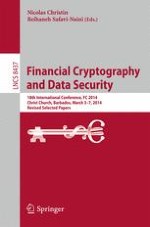2014 | OriginalPaper | Chapter
Mixcoin: Anonymity for Bitcoin with Accountable Mixes
Authors : Joseph Bonneau, Arvind Narayanan, Andrew Miller, Jeremy Clark, Joshua A. Kroll, Edward W. Felten
Published in: Financial Cryptography and Data Security
Publisher: Springer Berlin Heidelberg
Activate our intelligent search to find suitable subject content or patents.
Select sections of text to find matching patents with Artificial Intelligence. powered by
Select sections of text to find additional relevant content using AI-assisted search. powered by
